 Elston Elston
All Saints
Glass
Click the numbers in the key plan for details of the items.
Chancel
1. In the north window of the Chancel there is a Victorian stained glass window depicting and unknown saint in memory of Robert Alvey Darwin who inherited Elston on the death of his father William Brown Darwin in 1842. Sadly he died 5 years later at the early age of 21 years. The inscription on the glass reads: In the north window of the Chancel there is a Victorian stained glass window depicting and unknown saint in memory of Robert Alvey Darwin who inherited Elston on the death of his father William Brown Darwin in 1842. Sadly he died 5 years later at the early age of 21 years. The inscription on the glass reads:
| To the glory of God and in memory of Robert Alvey Darwin died 7th Dec 1847 |
2.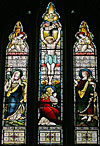 The east end window behind the altar portrays the crucifixion and is in memory of Charlotte Darwin who died in June 1885, and was erected by her husband Francis Darwin. This beautiful window was designed by three men who produced outstanding stained glass windows from 1855 onwards – Clement Heaton (1824 – 1882), James Butler (1830-1913) and Robert Bayne (1837-1915). Their company was one of the leading firms of Gothic Revival whose work was commissioned by the leading Victorian architects of the day. From 1862 Robert Bayne became their sole designer and his windows show strong colour and are often recognisable by the inclusion of at least one figure with Bayne’s features and long beard. The extended range of colours in the stained glass windows were a result of Clement Heaton’s research into pigments. Of interesting note is the unusual but entirely natural use of turquoise for Christ’s loincloth in the window which works perfectly amongst the range of colours. Their work can be found in many places including Westminster Abbey, Emmanuel College, Cambridge and Peterborough Cathedral. The east end window behind the altar portrays the crucifixion and is in memory of Charlotte Darwin who died in June 1885, and was erected by her husband Francis Darwin. This beautiful window was designed by three men who produced outstanding stained glass windows from 1855 onwards – Clement Heaton (1824 – 1882), James Butler (1830-1913) and Robert Bayne (1837-1915). Their company was one of the leading firms of Gothic Revival whose work was commissioned by the leading Victorian architects of the day. From 1862 Robert Bayne became their sole designer and his windows show strong colour and are often recognisable by the inclusion of at least one figure with Bayne’s features and long beard. The extended range of colours in the stained glass windows were a result of Clement Heaton’s research into pigments. Of interesting note is the unusual but entirely natural use of turquoise for Christ’s loincloth in the window which works perfectly amongst the range of colours. Their work can be found in many places including Westminster Abbey, Emmanuel College, Cambridge and Peterborough Cathedral.
TO THE GLORY OF
GOD
AND IN LOVING MEMORY
OF HIS WIFE
CHARLOTTE M.C. DARWIN
THE DAUGHTER OF
W.B. DARWIN
OF ELSTON
WHO FELL ASLEEP
22ND JUNE 1885,
THIS WINDOW
WAS ERECTED
BY HER HUSBAND
FRANCIS DARWIN
OF ELSTON
AND CRESKELD,
Co YORK. |
3-4.
 Window 3 Window 3 |
 Window4 Window4 |
Both two-light windows in the south chancel wall contain patterned glass.
South Aisle
5.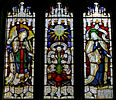 The stained glass east facing south aisle window representing the annunciation of the blessed Virgin Mary is by the celebrated Victorian stained glass artist and designer Herbert Bryans (1856 -1925) whose initial training was with Charles Kempe from about 1889. His motif of a running greyhound is clearly visible and normally appears in the bottom right hand corner of the memorial inscription in the window. It is in black and the dog is running towards the left. In some cases the motif is placed in the picture and is often hard to find among all the detail of the window. In a few cases the dog is yellow or white. In this instance the dog is black. An inscription within the window reads: The stained glass east facing south aisle window representing the annunciation of the blessed Virgin Mary is by the celebrated Victorian stained glass artist and designer Herbert Bryans (1856 -1925) whose initial training was with Charles Kempe from about 1889. His motif of a running greyhound is clearly visible and normally appears in the bottom right hand corner of the memorial inscription in the window. It is in black and the dog is running towards the left. In some cases the motif is placed in the picture and is often hard to find among all the detail of the window. In a few cases the dog is yellow or white. In this instance the dog is black. An inscription within the window reads:
Giving thanks to God
for the beloved memory
of John Lloyd Wharton
these three windows are
are dedicated by Mary
Dorothea Darwin 1913
|
Mary Dorothea was the only child of the Rt. Hon. John Lloyd Wharton.
6-7.
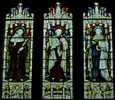 Window 6 Window 6 |
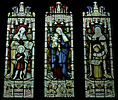 Window 7 Window 7 |
The south facing windows of the south aisle are also by Herbert Bryans which depict in the three lights, Saint Francis of Assisi, St. John the Evangelist and Saint Gilbertus of Sempringham in static pose. The second south facing window also with three lights depict Saint Elizabeth with John the Baptist, the Blessed Virgin Mary and Child, and in the third light Saint Anna with Timothy. The figures are realistically drawn with contemporary faces and their clothes are rich in detail, colour and texture. Unfortunately there are no extant records of the Bryans Studio so that it is not possible to know how many windows were produced or where they are all located around the country. But at least 200 churches have windows by Herbert Bryans and the total number of windows is well over 300.
8.The westernmost window of the south wall of the south aisle contains plain glass.
9. The small south aisle west window depicts the baptism of Christ by St John the Baptist. This is attributed to the Victorian stained glass designer William Wailes (1808-1881). The window contains a memorial to Harry Cazalet Harrison, thought to be a son of the Rector of Elston, the Rev H R Harrison, who died in December 1851. The inscription reads: The small south aisle west window depicts the baptism of Christ by St John the Baptist. This is attributed to the Victorian stained glass designer William Wailes (1808-1881). The window contains a memorial to Harry Cazalet Harrison, thought to be a son of the Rector of Elston, the Rev H R Harrison, who died in December 1851. The inscription reads:
| In Memoriam Harry Cazalet Harrison Renati 14 December 1851. |
The Rector sadly died only two years later at the age of 50 years.
Tower
10.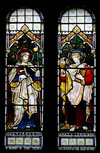 The west window depicts in two lights St James and St John with a memorial to John Thorpe of Elston Hall who died in 1881 and is buried in the churchyard in a distinctive granite sarcophagus inscribed with Celtic symbols. The inscription reads: The west window depicts in two lights St James and St John with a memorial to John Thorpe of Elston Hall who died in 1881 and is buried in the churchyard in a distinctive granite sarcophagus inscribed with Celtic symbols. The inscription reads:
In Memory of John Thorpe Died August 15th 1881 aged 81 years |
North Aisle
11.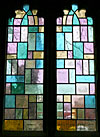 The westernmost plain glass window bears an inscription which reads: The westernmost plain glass window bears an inscription which reads:
In Memory of Harry Martin 1910 -1979 and his wife Ethel Martin 1912 -1999 |
12.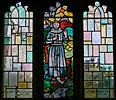 A stained glass window of three lights in the north aisle depicts St Francis of Assisi and the world of nature and was completed in 1989. The window is the work of Paul Quail, a leading stained glass artist who died in 2010 and whose work can be found in many Norfolk churches. The inscription reads: A stained glass window of three lights in the north aisle depicts St Francis of Assisi and the world of nature and was completed in 1989. The window is the work of Paul Quail, a leading stained glass artist who died in 2010 and whose work can be found in many Norfolk churches. The inscription reads:
| In memory of Jack Evans priest 1903 - 1971 and Ruth his wife 1907 – 1987. |
The window was installed in October 1989 and dedicated by the Archdeacon of Newark on 5th November 1989.
13.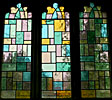 The remaining stained glass window with plain coloured panes of glass in the north aisle has an inscription which reads: The remaining stained glass window with plain coloured panes of glass in the north aisle has an inscription which reads:
| In memory of Richard Derek Clare 1921 – 1999 |
Clerestory
The only north-facing clerestory window in the nave bearing an inscription reads
| In memory of Trevor Wall DFM 1924 – 1999 |
There are three plain south-facing clerestory windows in the nave with inscriptions. The first reads:
In Memory of June Walker
1942 -2003 |
and
In Memory of
Clarence Herbert Walker
1900 – 1992
and Alice Walker
1905 – 2001 |
The second reads:
In Memory of Archibald C. Wood
(1916 – 1996) and
Phyllis M. Wood (1922 - 1965)
of Ealing, London |
The third reads:
In Memory of Donald T. Campbell
(1909 -1993) and
Joan P. Campbell (1913 – 1991)
of West Dulwich, London |
Further information about the lives of those remembered in those windows as well as their photographs may be found in Robin Campbell’s publication All Saints Church Memorial Trail (2010).
|